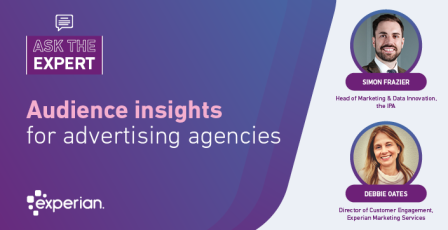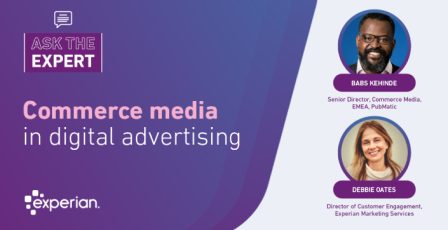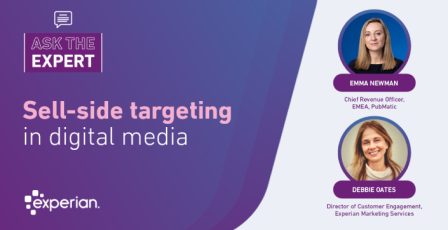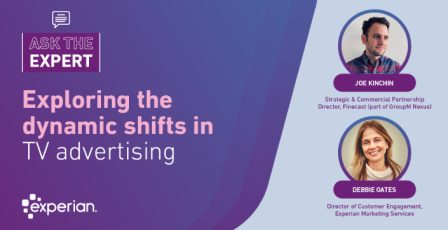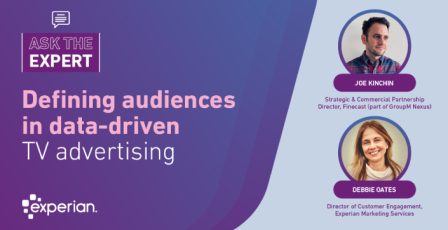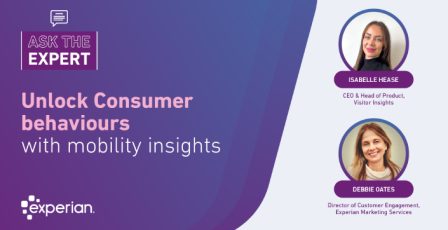Ask the Expert: Top questions from brands and agencies
Ask the Expert: A Q&A series with AdTech and data intelligence experts
Embark on an insightful journey into the ever-evolving landscape of digital advertising with our ‘Ask the Expert’ Q&A series.
In this episode of our “Ask the Expert” series, we’re excited to present a special edition featuring our go-to-market teams at Experian Marketing Services, Josh Torok, Strategic Partnerships & Digital Partnerships Consultant, and Danny Holmes, Principal Consultant, who have collated some of the most pressing questions from brands, agencies, partners, ad tech companies, and publishers.
Balancing data-driven insight with consumer privacy
One of the standout questions comes from brands, focusing on the intricate balance between creating rich customer profiles and maintaining consumer privacy. Danny explains that while data has always been crucial, its significance has surged in recent years. The influx of data into the market presents both opportunities and challenges, leading to what some call “data overload.”
Danny emphasises the importance of not losing the human element amidst the sea of data. He suggests viewing customer profiles as a puzzle with four core pieces:
- Who: Demographic and geographic information.
- Attitudes: Understanding what drives consumer behaviour through psychographic and behavioural research data.
- Spend Insights: Analysing purchase behaviour to see where money is flowing and by who.
- Mobility Insights: Tracking where people go and analyse who those people are.
Quality audiences in a cookieless future
Agencies have raised concerns about obtaining quality audiences at scale in a cookieless future. With cookies becoming a thing of the past, it’s essential to explore alternative methods for audience targeting. Josh discusses several approaches to cookieless targeting, including geo-level targeting, contextual advertising, and first-party IDs. While it’s promising to see numerous alternatives to cookies emerging, it’s essential to recognise that each alternative has limitations and is not a perfect one-to-one replacement for third-party cookies.
Bridging the gap between insight and activation
Often, brands struggle to translate their valuable insights into actionable campaign strategies. Josh highlights the disconnect between the brand’s CRM insights and agency media planning. He emphasises the importance of utilising the rich insights generated from CRM data and seamlessly integrating them into media plans and activation strategies. This ensures that brands maximise the value of their data investments and achieve optimal campaign performance.
Evolving measurement solutions
The cookieless future presents challenges for measurement, impacting both direct touch attribution and A/B testing. However, Danny remains optimistic about the potential of the unified measurement framework, acknowledging the need for adaptability in a constantly evolving landscape. He also emphasises Experian’s approach to measurement, leveraging data linkage and insights to connect impressions with customer activity and measure campaign effectiveness.
Standing out in a crowded market
Agencies are constantly seeking ways to differentiate themselves and offer unique value propositions. Josh suggests leveraging Experian’s data expertise and analytical capabilities to develop innovative solutions and tell compelling customer stories. He highlights the importance of data scale and breadth, allowing agencies to explore diverse data sources and create unique and effective strategies for their clients.
Identity and addressability
Danny shares three key pillars of market conversation and solutions:
- Identity or resolution: This involves taking multiple signals and resolving them back to a household.
- Alternative IDs: These emulate third-party cookies in a more privacy-centric manner, using deterministic and probabilistic methods.
- Cohorts and contextual analysis: This approach targets people with similar affinities and interests, requiring less data and proving to be quite popular.
When considering what people should be doing and thinking about, it’s essential to recognise that there is no one-size-fits-all solution. Brands need to evaluate their unique circumstances, ambitions, and tech stacks. Critical questions to ask about any solution include:
- Is it privacy-centric?
- Is it scalable?
- Is it flexible to adapt to changing technologies and industry landscapes?
Conclusion
Josh and Danny address some of the key questions from brands and agencies around insights and data in the digital marketing industry. They emphasise the importance of privacy-centric solutions, scalability, and adaptability in the ever-changing digital landscape.
By utilising Experian’s Consumer Sync, businesses can effectively link offline and online data, gain valuable market insights, and optimise their media strategies across various activation areas, including televisions, CTV, and retail media. Their insights offer a clear path for brands and agencies looking to enhance their audience engagement and drive growth in a competitive market.
Become an Experian agency partner
Our data and identity solutions help agency partners better understand and reach their audiences, enable accurate campaign attribution, and rely on accurate data with high match rates to reach new heights of client success.
Our comprehensive suite of marketing solutions helps agencies:
- Onboard offline first-party data into the digital ecosystem
- Leverage our broad range of consumer insights, including demographics, spending habits, mobility, and research data, to better understand your audience
- Select or build scalable audiences through syndicated and custom data sets
- Reach audiences across programmatic, CTV, social, linear TV, email, and direct mail
Connect with our expert team
Let Experian be your partner in helping your clients succeed.
Start connectingWelcome back to Ask the Expert.
This week we’re doing something a little bit different.
What we’ve done is we’ve gone to our go to market teams who sit down with brands, agencies, partners ad tech companies, publishers, etc.
and we’ve asked them to feedback on some of the questions that are really interesting or that stand out from discussions that they’ve had.
And we thought we’d answer them here today.
All right.
Question for you, Danny.
This one’s from brands.
And it’s about data and insight.
How can you do a rich profile of a customer while still taking into account consumer privacy? Privacy is of utmost importance in today’s world.
And I will come on to privacy.
But first, I think it’s key to talk about data more generally.
Data is well, it has always been, it’s been king for a long time, but it’s particularly ramped up in recent years with that increased interest.
There’s an increase in supply into the market, which means there’s an increasing opportunity, but also means there is a little bit of noise in the market right now in terms of data, and people will often refer to it as potentially a data overload.
That means that in certain insight projects, people can look at people or individuals as just pixels in a sea of big data, right? And missing out that, that human element.
And I think that lack of empathy right now is a bit of an issue.
And it’s important that people trying to think about that in some of their projects that they are, they are doing.
So I think right now that it’s critical to balance both scale and depth of insight, and the way we see that is really looking at it from almost like a profile puzzle.
Right? And there are pieces to that puzzle and there are many pieces, and I think there are four core pieces.
The way that particularly the way I see it is, there is the who.
So that’s your demographic, geographic level information, of which there are many suppliers in the market.
And of course, Experian has theirs with the likes of Consumer View and Mosaic.
Then there is, what are people’s attitudes? What do they think? What’s driving them to do certain behaviors.
And that really comes down to often survey level data.
So we do some great work there with the likes of YouGov.
Third is then what are people doing.
So money talks.
So having access to purchase behaviour allows us to see where money is flowing and who it’s flowing to and what spending it on.
And Experian will play in that field.
We have our spend panel of 4 million, we can look at where money is flowing.
But also we peg that to our segmentation to see not only where is money being spent but by whom.
So that’s an added layer of insight that I think is unique right now.
And then the fourth is around where people go in and how they navigate it.
And that really comes down to mobility level data.
So which is driven by the likes of SDKs or GPS.
And again it’s another arena that experience our planning.
And we can again not only look at where people are going, but also we can pair that again with our segmentation to know where people are going.
But who are those people that are going there? So once we’ve looked at all those pieces of the puzzle and again, it may be those four, it may be others, it’s important to look at it from a privacy lens to make sure that, um, the strictest levels of privacy are embedded into the insights that you’re gathering.
At Experian, we do our utmost to make sure that consumers are well-aware of what we’re doing with their data, and they can opt out, any time.
So look, it’s a busy it’s a busy place.
It’s a busy market.
There’s a lot of insight out there.
The key is to capture it and is to then look at how you can validate that out and talk to friends, family, your own customers to make sure that that insight is a true and fair representation of who they really are.
This one is from agencies.
How do we get quality audiences? Um, now that cookies are going and they’ve written in capital letters scale.
So the cookieless future, we’re here now.
There’s many different ways that you could approach it to get that scale.
GO levels always had it, but it’s lacking some of that granularity.
Contextual is great.
But you know, does it really say who the person is? And then you’ve got first party IDs or authentication.
Then you come back to our capitalised letter on the card, which is scale.
What we’ve done is we’ve built a solution that works at household level.
It gives that granularity that really effective, and it lines together between IDs and IP address and basically is currently operating at a household level of around 60% coverage, which is massive, especially for a granular level of data like that.
And then we can layer on to it, you know, experience treasure chest of attributes.
And that makes it an adaptable format that can be used in a number of areas for activation and television, for CTV, for retail media, whichever area we can connect the audiences to it.
So let’s go on to the next question.
This one is from brands.
So I do hear this one quite often actually.
But why is our agency not using our insight work in our campaigns.
So obviously brands do a lot of CRM work with us.
They get all this rich insight, they pay for our data and license it so that they can understand their customers when they get to work with their agency.
For some reason, there’s a disconnect between the work that they’re doing from a CRM perspective, and when the agencies are briefing out or putting together a plan for their media.
It’s almost like that insight work doesn’t get carried through into activation.
What the agency will do is often build an audience based around the details of the profile, rather than the actual profile itself.
So, for example, they’ll look at the substance of a mosaic profile 18 to 34 male affluent lives in city, etc.
and they’ll say, let’s go and target these people.
Rather than saying, well, we’re looking for mosaic Group A1.
They’re not carrying through from the insight work that they’ve done.
So they’re sort of missing a trick, in causing themselves a lot of extra work.
So the point of what we do, from an insight perspective and being able to support brands is to have these rich, deep insight audiences that they can use for that insight perspective, but then also just take straight out and activate and go to market with.
Those audiences are available on any channel that they want to advertise so it makes it simple and easy.
So that’s what we’ve been trying to do in the market, is to make sure that that disconnect between brands and agencies doesn’t happen, and that the agencies are aware of the amount of investment that these brands have done.
From an insight perspective on what Experian can do, and make sure that those audiences that they’re using, the insight work that they’ve done, carries through into the media plans and into that activation.
This one’s from brands.
How are you seeing measurement evolving? Is there a silver bullet measurement solution? I think the measurement industry is very interesting, at the minute.
It’s actually a passion point of mine.
I mean, I come from a digital publisher background.
So measurement is key.
So if you don’t have a good measurement proposition, you just sell an idea.
You don’t sell a solution.
So, I think there’s a lot of great work that’s been done in it.
I think cookies really will affect, we all know that will affect, measurement both I guess predominantly from a direct touch but also A-B testing.
But again, there are smart people doing some smart things to find solutions.
I read a lot about the unified measurement framework.
I think there’s a lot of people working towards that.
It’s a great endeavor.
I have my concerns sometimes because the world is full of disruption and new channels and new data feeds and so a new regulation.
So maybe a static framework has holes that can be picked at, but I think it’s certainly valuable work that’s being done.
From our side, we see measurement as, as leveraging our, our linkage and, but also the depth of insight that we have.
So how do you pair that impression with some sort of activity, whether that’s a sign up, a conversion, or simply just any kind of engagement.
So connecting those journeys to unify or connecting those touchpoints to unify a customer journey.
But then how do you use the added layer of insight that we have to look at, let’s say, incrementality using our spend data or let’s say increase footfall using our mobility data? And yeah, we’re having some really interesting conversations with clients about that right now.
Some really healthy ones.
But I guess to answer the original question, there’s no silver bullet right now, unfortunately.
So this one is from agencies.
So how can we be more unique or have an offering that stands out? This is one that agencies have been asking more and more.
If you go with a straight SAAS solution or some of the amazing partners that we work with or some of the set software opportunities, you are sort of buying into something that doesn’t give you that wiggle room to do something a bit different.
I think that’s where, you know, what we’ve found working with us has been quite helpful.
You know, we fill out our, backrooms with analysts who look and try to do different and interesting things with data.
Data creates a wealth of opportunities for different ways that you can do things, different ways that you can tell different stories or understand your customers or create unique and different solutions.
So that scale of that data is key to being able to make that happen, but also the breadth of data solutions that you plug into, whether it’s transactional, whether it’s mobility, whether it’s sociodemographic insight.
All of that creates different stories that you can put together.
And the agency can offer a different solution that helps them stand out in the market.
We’ve done some projects.
We worked with one agency that was dealing with quite a large auto brand.
We built them an auto planner, so that was using some of our sociodemographic data combined with auto vehicle data, and we built them a very simple tool that allows them to understand the audience in three ways.
The core customers, the ones that index towards your brand but are not the ones that you’d normally consider, and then your competitor customers.
So the ones based around that competitor data that we have in our platform.
So it meant that they’ve got a tool that helps them pull different audiences at different sizes and different scales that they could just quickly, easily turn into an activation plan.
That’s the goal of what we’re trying to do is, what can we do to work with brands or agencies to help them stand out in the market? That’s, I think, at the core of what we try to do.
Identity and addressability.
What’s the industry saying about addressability and identity? This is a, I think, a fascinating industry.
It’s so fast paced.
At the minute, there are some very intelligent people doing some very smart things to try and solve a pretty big problem.
But I think to go on to the question, so what is the market saying? I think there are probably three key pillars of topics of conversation and types of solutions.
So there is identity or resolution.
So this is taking multiple signals and resolving that back to a household.
And there are alternative IDs which are really there to emulate third party cookies in a way, but in a much more privacy-centric way.
They use both deterministic and probabilistic methods within that, both with, with their own merits.
And then the third is, is really around sort of cohorts and contextual analysis or using cohort or contextual signals to try and target people with similar affinities and interests.
It’s a much, much less heavier requirement on data for that particular solution, so that’s been relatively popular.
I think to the question of what people should be doing and what people should be thinking about.
I probably would say if there’s no one size fits all, you really need to look at your own company, your size, your ambitions, your tech stack.
But then looking to maybe ask three questions for any solution is this privacy centric? So it needs to have privacy built into the foundations.
And if not, it won’t stand the test of time, particularly in this industry.
The second is, is it scalable.
Right.
So we talked before about deterministic and probabilistic deterministic less has more of an issue with scale compared to probabilistic.
So those things need to be weighed up.
And the third is, is it flexible? So will it move with the times.
Times are changing.
Technology is changing.
Particularly in recent years.
So you need to find something that is flexible, and will move, as the industry moves.
And yeah, at Experian, we launched our product, in December, consumer sync, which looks to overcome some of these challenges and to answer some of these questions that I just referenced.
All right.
Next question.
Can you share any data or insight on our competitors? I think everybody is asking that lone.
We do have within Experian now, our spend panel of 4 million.
So I spend data insights and we peg that or we match that against our segmentation mosaic.
So we can look at where spend is going in the market and who that is being spent by, right? So that could be your own brands.
And so you capture a profile of people who buy your product, and when, but also of competitors.
So yeah.
So you can understand the I guess the seasonality, the average order value, the types of people that your competitors have as their, as their customer set.
And also your market share to keep a tab on, exactly how that is evolving due to your marketing efforts.
So in short, yes.
Okay.
Last question.
Let’s hope it’s a good one.
How do we get involved in retail media.
So there’s lots of brands, retailers, that are trying to get involved in retail media.
And I think the first step that we take them through is onboarding.
They’ve got offline data maybe from, you know, loyalty cards, but then they’ve also got traffic to their websites that they don’t know who these people are.
What we can do is we can shed a light on who those people are that are, you know, they’re not they’re logged in users.
Compare that to the people that are they’re logged in users and then help build that into a graph for them, that then we can take those audiences and help them.
We can either build a bespoke taxonomy for them that they might want to plug into other systems, or they might want to make that available to agencies to run campaigns on.
Or we can help them target those audiences and build a set of bespoke audiences based around their loyalty card data, combined with Experian socio-demographic data, and give them a rich taxonomy of customers that they can target, or audiences that they can sell to brands that might want to advertise on their retail media or to utilize those audiences in external environments.
So once you’ve done the onboarding, then it’s about the scaling, and that’s where Experian really excels.
We’re so used to taking small subsets of audiences and scaling it against the UK population, and that’s what we can do for retailers especially when you’re building a retail media solution.
Once we’ve done that scaling work, then it’s about being able to push it through, our network, our partner network and out to all those activation channels.
They can either sell on their own property that we can make these audiences targetable on their own inventory, or against broader inventory sets, across the broader internet, they can take those audiences and find them, you know, wherever they might go online, on news websites, on CTV, wherever it happens to be.
And that’s the goal.
And that’s, I think, where the retail media market is such a buzzword and such a lucrative boost to this industry because it offers a whole new area of inventory and a whole new area of data to play with.
And that’s what Experian is looking to do, is to really help businesses, by being that powerhouse that can connect, scale that data, and deliver it into all those channels.
So that’s all the questions.
Yeah.
It’s been great to talk through them.
I’ve learned a lot.
So if you have any questions then feel free to fire them across and we will answer them or we will include them in the next episode.
